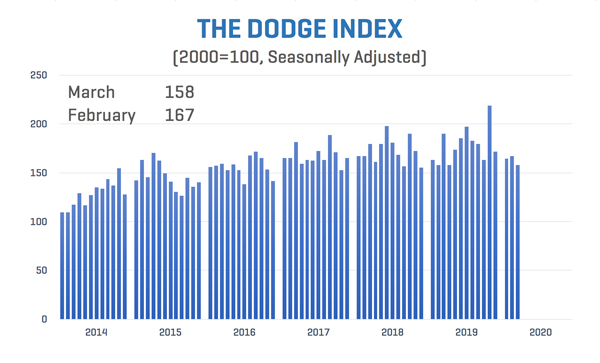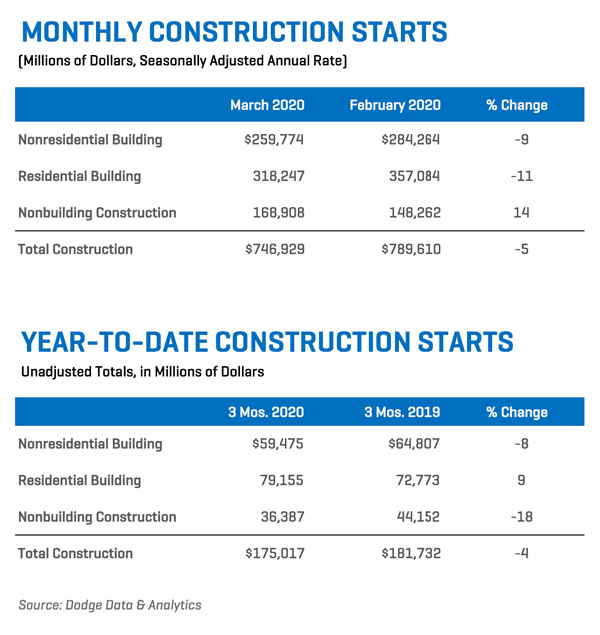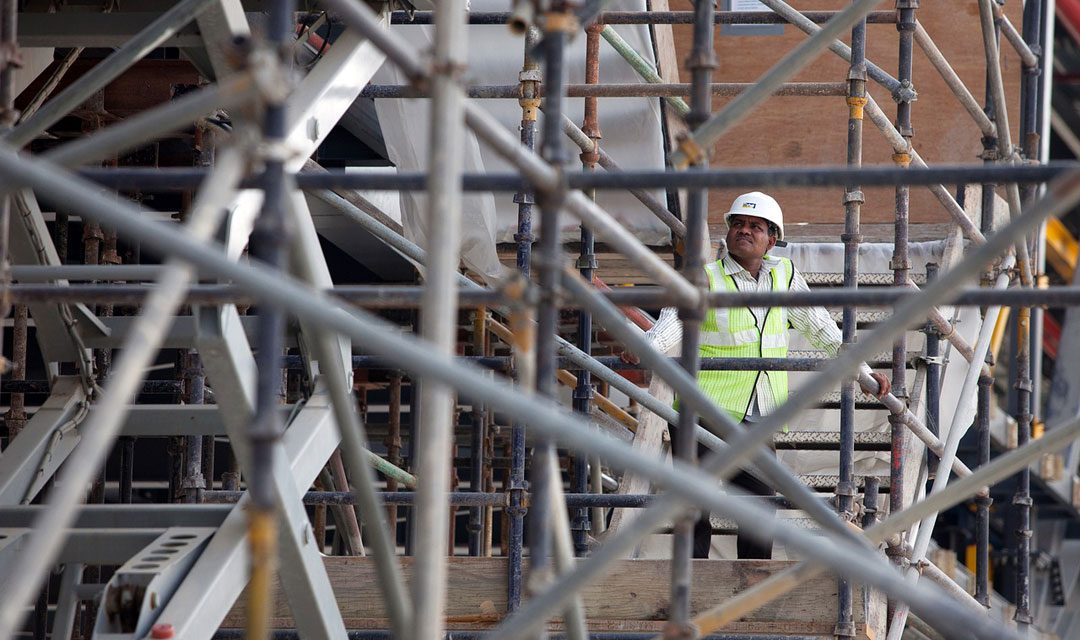Total construction starts declined 5% from February to March to a seasonally adjusted annual rate of $746.9 billion. Volatility caused by the presence or absence of large projects in healthcare and the utility/gas plant category, however, skewed the analysis. In March, nonresidential building starts fell 9% from February (seasonally adjusted), while residential building dropped 11%. Nonbuilding construction starts, however, rose 14% during the month.
For the 12 months ending March 2020, total construction starts were 2% higher than they were for the same period ending March 2019. Residential building starts were 3% higher, while nonbuilding starts were up 5% for the 12 months ending March 2020. Nonresidential building starts, however, were down less than one percent. The Dodge Index dropped to 158 (2000=100) in March from the 167 posted in February.

Source: Dodge Data & Analytics
“Considering the calamity that occurred towards the end of March as the fallout from the COVID-19 (Coronavirus) hit the economy, construction starts held up rather well,” stated Richard Branch Chief Economist for Dodge Data & Analytics. “Construction starts in March were unlikely to be greatly impacted as projects that broke ground during the month likely had materials sourced and in-place and labor booked well ahead of the scheduled groundbreaking. That momentum and planning is difficult to reverse at the last minute. Additionally, most of the stay-at-home orders and construction moratoriums were not instituted until the last week of the month and into April. Therefore, April construction starts are likely to be a very different story with states like New York, New Jersey, and Pennsylvania among others banning construction activity. April’s starts data will be the first true indication of how the crisis will impact the construction industry.”

Nonbuilding construction jumped 14% in March to a seasonally adjusted annual rate of $168.9 billion due to the start of several large electric power facilities. When the massive 161% gain in the utility/gas plant category is removed from the total, nonbuilding starts fell 9% during the month. Highway and bridge starts rose 5%, although the environmental public works category dropped 5% and the miscellaneous nonbuilding category fell 44%.
The largest nonbuilding project to break ground in March was the $1.0 billion 1,085 MW Indeck Niles Energy Center power plant in Niles MI. Also starting in March were the $600 million Jordan Creek Wind Farm in Williamsport IN and the $469 million Titan Solar Project in Culberson county TX.
For the twelve months ending March 2020, total nonbuilding starts were 5% higher than the twelve months ending March 2019. Starts in the utility/gas plant category were 62% higher, while environmental public works were down slightly. Street and bridge starts were 5% lower for the twelve months ending March, while miscellaneous nonbuilding was down 15%.
Nonresidential building starts fell 9% in from February to March to a seasonally adjusted $259.8 billion. Commercial building starts were 5% lower, with losses in three of the five commercial sub-categories (warehouses and parking structures made gains). Manufacturing buildings dropped 7% during the month, while institutional buildings dropped 12%. Institutional buildings posted a large gain in February due to the start of several large healthcare facilities, which were not present in the March statistics. However, education facilities posted a solid 18% gain in March.
The largest nonresidential building project to break ground in March was the $616 million Duncan Neuroscience Research Facility in Saint Louis MO. Also getting started in March was a $415 million Amazon fulfillment warehouse in Wilmington DE and a $369 million Amazon fulfillment center in Colorado Springs CO.
On a 12 month total basis, nonresidential building starts were less than one percentage point lower than they were for the 12 months ending March 2019. Commercial starts were up 2%, while institutional building starts were 1% lower and manufacturing starts were down 7%.
Residential building starts moved 11% lower in March to a seasonally adjusted annual rate of $318.2 billion. During the month, single family starts dropped 14%, while multifamily starts lost 3%.
The largest multifamily structure to break ground during in March was the $420 million Hunter’s Point South Mixed-Use building in Long Island City NY. Also starting during the month was the $200 million Piazza Terminal Mixed-Use building in Philadelphia PA and the $125 million Adeline Residences in Phoenix AZ.
For the 12 months ending in March, total residential starts were 3% higher than the 12 months ending March 2019. Single family starts were up 5%, while multifamily building starts were less than one percent lower.
Related: “Dodge Momentum Index eases back in March”


